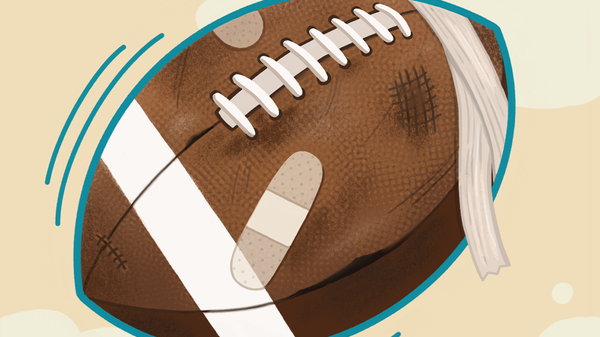
The Super Bowl is a once-a-year event that provides endless material for commentators and fans to dissect. As Super Bowl LIII stretched into its final quarter on Sunday, it seemed to have been unanimously declared “the most boring Super Bowl ever,” with a final score of 13-3 making it the lowest-scoring championship match in professional football history. Rather than rehash what made the game so boring—Twitter users have taken care of that!—we asked members of our physical therapy faculty to tell us what caught their eye while watching a game that so often leaves players with serious injuries.
'...a kind of contact enabled by improvements to protective gear'
W. Geoffrey Wright, director of neuromotor science programs and assistant professor of physical therapy and bioengineering
Since the Super Bowl on Sunday, fans and commentators have wondered whether Rams cornerback Nickell Robey-Coleman's helmet-to-helmet illegal contact penalty in the first quarter should have been called. The fairness of the referee’s decision, however, is probably not the most important question. Helmet-to-helmet contact like Robey-Coleman’s hit on Patriots running back Rex Burkhead is the kind of physical roughness that can elicit concerns about professional football players’ neurological health. It’s also a kind of contact that’s been enabled by modern science’s improvements to protective sports gear.
Over 100 years ago, football was on the brink of extinction due to excessive violence. Over 20 players died each year, often due to head and neck injuries. Then president Teddy Roosevelt made an executive decision to intervene to try to save football. He brought together coaches and commissioners and urged them to sign agreements to change the game’s rules and reduce the violence. Fast forward 100 years, and football is stronger than ever, and we rarely have a death on the field. Our modern armor may provide much greater protection and even give players a sense of invulnerability, but in turn, it does allow the accumulation of thousands of body-jarring blows that could lead to severe health issues later in life. It’s interesting to wonder if Robey-Coleman would ever lead with his head to tackle if he weren’t wearing protection. It’s also valuable to ask if modern science could predict just how many or few head blows someone could sustain before permanent long-term damage would be expected.
'a long and arduous process'
Scott Burns, director of the Doctor of Physical Therapy program and associate professor of instruction
In the lowest-scoring Super Bowl in history, Patriots wide receiver Julian Edelman was named Most Valuable Player for his remarkable 10-catch performance. At times, Edelman looked faster than all of the defenders. This is remarkable considering that just a year and a half ago, he sustained an anterior cruciate ligament (ACL) tear in his right knee and sat out the entire 2017 season. Physical therapy is often a large component of the rehabilitation process following ACL surgery, and it can be a long and arduous process. Typically, it is recommended that an athlete may start to return to playing their sport 9 months after surgery, if they meet certain recovery criteria. Edelman went to physical therapy and rehabilitation 6 days per week for several hours per day and had access to state-of-the-art equipment and numerous healthcare providers to assist with his recovery.
In the United States, surgeons repair approximately 100,000 ACL tears per year, and many of the people who receive these surgeries will want to recover at a rate comparable to professional athletes’ such as Edelman’s. This expectation often leads to becoming more discouraged with their recovery and potentially hindering their ability to successfully return to their desired activities. Often individuals recovering from an ACL surgery do not take into account that, when injured, professional athletes are paid to rehabilitate their injuries and can devote significantly more time and energy to their recovery. If you are recovering from an ACL surgery, don’t compare yourself to the professional athletes, just focus on your own recovery and getting back to the things you enjoy. You don’t play for a team that needs another Super Bowl win!
'...exceeded expectations of a player who returned after acl surgery'
William Egan, director of the Orthopedic Residency program and associate professor of instruction
This year’s Super Bowl, the lowest-scoring in football history, was notable for another reason: how little the Rams’ star running back Todd Gurley, who ran 1,800 rushing-yards in the regular season, was able to produce on the field. By halftime, he had only run 10 yards on three attempts, and he finished the game with only 35 rushing yards on 10 attempts.
Patriots coach Bill Belichick is known for employing defensive schemes built to take away the opposing team’s best player. This was certainly true last night, when the Patriots employed stout line defense to stop Gurley’s favored outside runs. However, watching Gurley closely, it was evident that he lacked his signature quickness and explosiveness that make him one of the NFL’s most exciting and dynamic young players. Though he totaled the third most rushing yards of any player during the regular season this year, Gurley sustained a significant injury to his knee early in the season and sat out the final two games of the year. Unfortunately, this is the same knee that Gurley underwent ACL reconstruction surgery on after Gurley injured himself, tearing his ACL in 2014 while a star college running back for the Georgia Bulldogs.
Before and after the game, Gurley and the Rams claimed that his knee was not an issue. Observing him playing suggests otherwise. We should commend Gurley for having successfully battled through almost an entire NFL season with a painful and inflamed knee in one the most physically demanding positions in football. Gurley’s four-year NFL performance has exceeded expectations of a player who has returned after ACL reconstruction surgery. Sadly, studies show that the careers of NFL players who have undergone ACL reconstruction are typically shorter. Let’s hope an offseason of rest and rehabilitation will return Gurley to his star player status.
